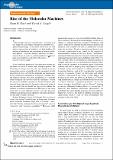Rise of the molecular machines
Citation
Kay , E R & Leigh , D A 2015 , ' Rise of the molecular machines ' , Angewandte Chemie International Edition , vol. 54 , no. 35 , pp. 10080–10088 . https://doi.org/10.1002/anie.201503375
Publication
Angewandte Chemie International Edition
Status
Peer reviewed
ISSN
1521-3773Type
Journal article
Description
The authors thank the EPSRC, ERC, and the Leverhulme Trust for supporting our research programs on molecular machines. E.R.K. is a Royal Society of Edinburgh/Scottish Government Personal Research Fellow.Collections
Items in the St Andrews Research Repository are protected by copyright, with all rights reserved, unless otherwise indicated.
Related items
Showing items related by title, author, creator and subject.
-
Synthesis, and spectroscopic and structural characterization of three new styrylquinoline–benzimidazole hybrids
Ardila, Diana M.; Rodriguez, Diego F.; Palma, Alirio; Diaz, Ivan; Cobo, Justo; Glidewell, Christopher (2022-11-01) - Journal articleThree new 4-styrylquinoline–benzimidazole hybrids have been synthesized using a reaction sequence in which 2-methylquinoline precursors first undergo selective oxidation by selenium dioxide to form the corresponding ... -
Li@C₆₀, the molecular maraca : exploring the properties of lithium endohedral fullerenes on transition metal surfaces for potential use in molecular electronics
Chandler, Henry James (University of St Andrews, 2020-12-01) - ThesisThe following thesis describes the exploration of lithium endohedral fullerenes (Li@C₆₀) on Au(111) and Cu(110)-(2×1)O utilising an ultra-high vacuum low temperature scanning tunnelling microscope (UHV LT-STM). In collaboration ... -
Novel cambinol analogues as potential anticancer agents : an improved understanding of sirtuin isoform selectivity
Medda, Federico (University of St Andrews, 2011-06-22) - ThesisSIRT1 and SIRT2 are two NAD⁺-dependent deacetylases which negatively modulate the activity of p53, a protein which is involved in cell cycle arrest, senescence and apoptosis following genotoxic stress. Part I of the thesis ...

